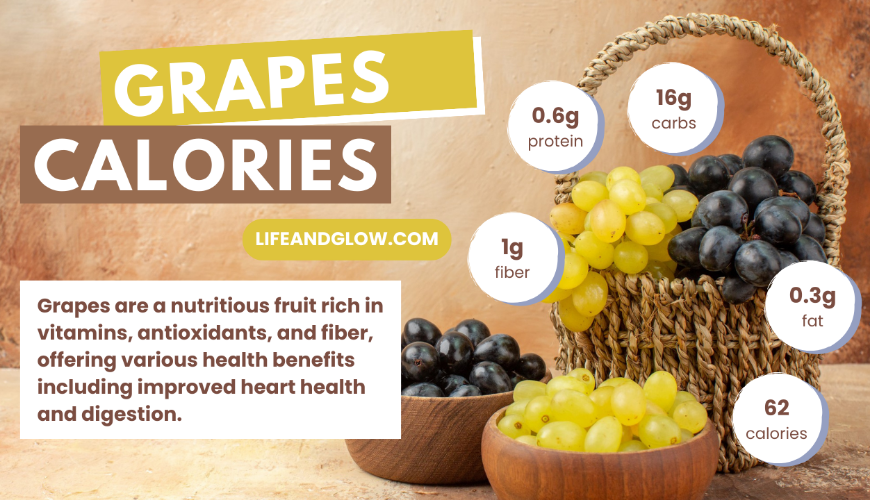The plentiful charm of grapes is not merely captivating to the gaze but also satiating for the taste buds. Regarded as a crucial constituent in wine production, grape varieties differ substantially in shape, color, size and can offer a flavor spectrum from sweet to tangy.
Most grapes belong to the Vitis Vinifera species and are packed with antioxidants that fight diseases. These antioxidants fuel our perception that wine promotes heart health. Consuming fresh grapes offers an excellent natural snack option due to their sweetness combined with essential vitamins like C and K along with other beneficial phytonutrients.
Nutritional Value of Grapes
A serving size equivalent to a cup of grapes (92g) supplies 62 calories, alongside 0.6g protein, 16g carbs and barely any fat at just 0.3g. As an exceptional source of vitamins C and K among others, this data is supplied by the United States Department of Agriculture or USDA:
- Caloric Content: 62
- Total Fat Content: 0.3g
- Sodium Level: 2mg
- Carbohydrate Load: 16g
- Fiber Count: 1g
- Sugar Intake from One Serve: 15g
- Protein Availability per Serve : 0.6g
- Vitamin C in one Cup : 3.68mg
- Amount Of Vitamin K in Per Serving : 13.4mg
- Volume Of Vitamin A Found In a Cupful : 4.6mg
Sugars
The majority of energy that grapes provide are predominantly derived from carbohydrates, with sugars being the chief constituents. A single grape holds approximately a gram of carbohydrate content. Researchers have calculated the glycemic rank for grapes to be roughly 59, alongside an anticipated glycemic load of 11 for one serving cup size.
Top 7 Healthiest Sugar Substitutes
Fats
Grapes almost don’t contain any fats, delivering significantly less than a gram per each portion.
Proteins
You can find only 1 gram of protein in every serving portion of grapes. These fruits are excellent when combined with cheese and nuts. Not only that, these additions are high-protein foods which contribute to creating a well-rounded and fulfilling treat.
Nutrients in Grapes
Grapes are a prime provider of vitamin K and manganese. A solid quantity of vitamin C can also be acquired from them, which is vital for maintaining robust immunity and contributing to tissue repair processes like wound healing.
Energy Value
Fruit like grapes commonly contain approximately 62 energy units per cup on average. The luscious seedless red version of this fruit carries around 86 energy units for every 100g, a quantity a little over one cup. On the flip side, their green seedless counterparts hold an energy value of about eighty for each hundred grams.
Overview
Grapes are a fruit packed with vitamins and offer significant hydration. They abound in vitamins C, K, and A. Grapes are an antioxidant-rich reserve of carbohydrates while contributing negligibly to protein and fat content.
Calculating Your Ideal Protein Intake
Wellness Advantages
Grapes represent a delicious yet low-fat and low-calorie indulgence. For those aiming to decrease the consumption of manufactured foodstuffs or supplementary sugars, grapes could act as a suitable alternative for snack items such as biscuits and sweets. A majority of the wellness advantages associated with grapes can be attributed to their vitamin content.
Assisting In Coagulation Process
Vitamin K plays a crucial role in facilitating blood coagulation and maintaining bone strength. Important: If you’re on anticoagulants like Coumadin (warfarin) or similar medications, consistency in your vitamin K consumption is important. Consult with a medical professional about your dietary intake.
Deliver Antioxidants
Grapes are rich in phytonutrients, particularly significant is the abundance of flavonoids such as resveratrol (present predominantly in red grapes’ shells). These particular antioxidants in resveratrol could potentially aid in diminishing the likelihood of conditions like hypertension, hypercholesterolemia, blood thrombi formation and cardiovascular diseases.
In addition to this, grapes also possess another flavonoid named quercetin. It may aid cellular defense mechanisms against harm. For example, there’s certain supporting evidence that quercetin caters multiple wellness advantages including acting as an anti-inflammatory compound, antiviral element and an antioxidant agent.
Chlorophyll Drops – Nature’s Liquid Green Magic
Enhance Mental Processing
Various studies hint that intake of resveratrol (often through supplements) may aid in strengthening memory and mental processing for the elderly. Resveratrol is predominantly present in red grapes.
Control Glucose Levels
Studies have shown that resveratrol can offer aid to individuals living with type 2 diabetes. It’s suggested to potentially enhance blood sugar control and reduce resistance to insulin, providing significant benefits for diabetes patients.
Minimal in FODMAPs
Individuals affected by irritable bowel syndrome (IBS) and Crohn’s disease may suffer from digestive issues upon ingesting food that possesses high levels of FODMAPs (fermentable oligo-, di-, monosaccharides, and polyols — a group of short-chain carbohydrates). However, grapes are regarded as a low-FODMAP fruit.
Needless to say, wine is the product of fermented grapes. During this fermentation process, grape sugars transform into alcohol. Specific health advantages can be reaped through moderate consumption of wine that one might not get from consuming raw grapes. Particularly with red wine, it has been associated with lowered risks relating to cardiovascular wellness, diminished chances of Type 2 diabetes diagnosis, reduction in inflammation markers and known for its antioxidant properties which offer further protective effects.
Hypersensitivity
Physicians have discovered five principal allergens in grapes. Indications of an allergy to grapes might encompass urticaria, skin irritation, or inflammation and even severe shocks. Moreover, if you are allergic to other fruits as well, you could experience a reaction while ingesting grapes as stated by the American Academy of Allergy, Asthma & Immunology (AAAAI).
Negative Consequences
Consuming grapes could hinder blood coagulation due to their vitamin K count. You should seek advice from your medical professionals, particularly if you are on anticoagulants such as Coumadin (warfarin) and should keep an eye on your Vitamin K consumption.
Entire grapes pose a risk of choking for children aged 4 and below. Always slice the grapes into four parts before giving them to small children.
Types
Grape varieties, both of European and American origin, are cultivated in the United States. Europan version is largely grown in California for raisin production, while American grapes serve mainly for producing jams, jellies, juices and other edible items.
Numerous kinds of table grapes exist like white, black, green or deep red; including Adora, Almeria, Beauty seedless among others. Each variant has its unique taste with seeded ones being more flavorful though seedless types are more popular amongst consumers.
Deeper-shade colored grapes such as purple-reds and blacks possess a greater quantity of antioxidants than their green counterparts. However nutrient levels across grape variants do not vary significantly.
Although enriched with sugar becuase it’s often added during processing; grape jelly/jam or juice contain higher amount compared to fresh produce. Hence ingredients list scrutiny is essential . For instance 4 ounces serving size of whole grape juice contains around 18 grams sugar exceeding the mere 15g found in an entire cup full of fresh grapes whereas one tablespoon-loaded Grape Jelly includes around 10grams worth sugary content.
Optimal Timing
The assortment in your local grocery store can vary significantly depending on the time of year and geographical location due to the fact that various grape types are picked throughout summer and autumn. Regardless, imported grapes remain a constant presence whenever desired.
While buying grapes, pass over those showing signs of mold or shriveling. Select grapes displaying vibrant coloration. Green varieties taste the sweetest and have top-notch flavor when exhibiting a yellowish-green hue. Red and black sorts are superlative when deeply colored.
Preservation and Health Aspects of Grapes
Grapes adorned with a dusty white layer, named bloom, are not harmful for consumption. This natural substance is present to safeguard the grapes from getting damp and rotting. On occasions it may not rinse off effortlessly, however is unharmful when eaten.
Grapes can stay fresh in the fridge for several weeks if maintained correctly. Adhere to these guidelines for optimal storage:
-
Examine the outer appearance: Look out for mold signs, deflating or weak attachment of stalks. Any grapes exhibiting these symptoms may degrade speedily influencing others as well. Discard any that seem unfit.
-
Maintain chilliness: Keeping grapes cold enhances their shelf life. Locate them at the rear end of your refrigerator (the chilliest spot) while avoiding strong-smelling items such as onions since they might assimilate those smells.
-
Store in original packing: For preventing squashing of grapes leave them in their original packaging as typically it offers an appropriate amount of shield and airflow to aid in prolonging life span.
-
Avoid washing before storing: Like many fruits, refrain from washing grapes prior to storage as excessive moisture quickens decay process instead wash immediately before consuming.
-
Freeze optionals: To get extended utility out your grape stockpile freeze them which you can later add frozen into smoothies or cocktails or savour just by popping-in your mouth -a cool fruity refreshment!
Preparation Guide
Known primarily as a delightful snack consumed solely or blended in a fruit salad, grapes serve many other culinary purposes. Freshly-sourced grapes can inject unexpected sweetness into hearty salads and pair well with various olives and cheeses, thus making for an intriguing hors d’oeuvre. Consider roasting these fruits to complement meat-based plates.
Read more about other fruit:






